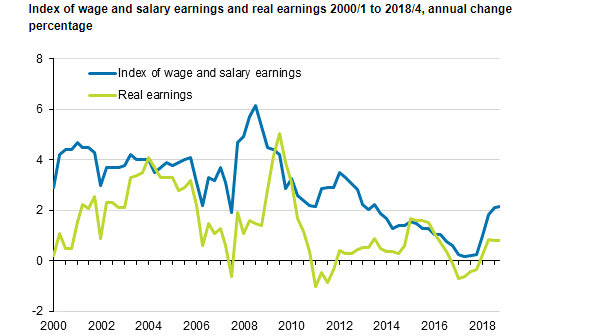According to Statistics Finland’s preliminary data, the nominal earnings of wage and salary earners rose by 2.2 per cent on average in October to December 2018 when compared to the respective period in 2017
However, the growth of the real earnings was not as pronounced. They rose by 0.8 per cent compared to the fourth quarter of the previous year, because the rise in earnings level was faster than that in consumer prices.

Statistics Finland’s preliminary data indicate that the nominal earnings of wage and salary earners rose from October to December 2017 to the corresponding period in 2018 by 2.3 per cent in the private sector, by 2.3 per cent in the central government sector and by 1.7 per cent in the local government sector.
Compared to the year before, the average increase in the level of earnings during 2018 was 1.8 per cent, whereas the increase in real earnings was 0.7 per cent according to preliminary data.
Regular earnings increased by 2.1 per cent
The index for regular earnings describes the permanent change in earnings better than the index of wage and salary earnings because it does not take into account performance-based bonuses and non-recurring items included in collective agreements.
According to Statistics Finland’s preliminary data, regular earnings rose by 2.1 per cent in October to December 2018 when compared with the respective period in 2017. The growth amounted to 2.3 per cent in the private sector, to 2.3 per cent in the central government sector, and to 1.7 per cent in the local government sector.
The indices are final as far as the year 2017 and they are based on final wage statistics. The indices for 2018 are still preliminary. They are based on the effects of agreements and the wage drift. In addition, the data on performance-based bonuses of the Labour Cost Index are used to assess performance-based bonuses in the calculation of the preliminary indices of the index of wage and salary earnings.










